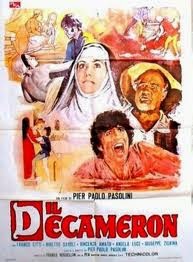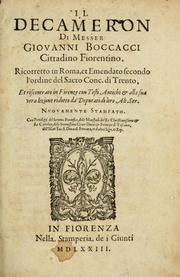 In Pasolini’s filmed version of The Decameron, he inexplicably leaves off Boccaccio’s frame story of a group of seven women and three men who retire to an estate in the country to avoid the plague that is ravaging Florence. There they tell each other stories to entertain, to cheer, and to instruct each other. Pasolini instead jumps right into a story, plays it out, then moves to another without explanation. He tells some interesting stories (and some of them are very sexy), but the film left me wondering why? What’s the point?
In Pasolini’s filmed version of The Decameron, he inexplicably leaves off Boccaccio’s frame story of a group of seven women and three men who retire to an estate in the country to avoid the plague that is ravaging Florence. There they tell each other stories to entertain, to cheer, and to instruct each other. Pasolini instead jumps right into a story, plays it out, then moves to another without explanation. He tells some interesting stories (and some of them are very sexy), but the film left me wondering why? What’s the point?
Without the frame story, I didn’t know what to do with the stories Pasolini was telling. Perhaps the frame story is the title of his series of films, “The Life Trilogy,” which I can interpret in various ways, or perhaps the frame story is what we know or can learn about Pasolini. In any case, the viewer is compelled to construct the missing framework to make sense of the film. Still, it was a mistake; the frame story of the plague, a dark and frightening setting, makes the comedies funnier, the love stories more romantic and the instructive stories more urgent.
 Is The Decameron metafiction? His principal character is Fiammetta, a character based on the love of his life, the blonde beauty, Maria, natural daughter of King Robert, whom he met in the church of San Lorenzo and who, though married, returned his gaze and his love. He wrote to her and for her and about her in his “Ameto,” “Amorosa Visione,” “the Teseide,” “the Filostrato,” and “L’Amorosa Fiammetta.” Since the character moves from one work to anotherm, the intertextuality is a metafictional element. The character herself is metaficional because Boccaccio acknowledges that the character as fiction based on a real woman. The fact that the real woman was from Naples not from Florence, indicates to readers that they shouldn’t take the portrayal of Fiammetta as literally Maria.
Is The Decameron metafiction? His principal character is Fiammetta, a character based on the love of his life, the blonde beauty, Maria, natural daughter of King Robert, whom he met in the church of San Lorenzo and who, though married, returned his gaze and his love. He wrote to her and for her and about her in his “Ameto,” “Amorosa Visione,” “the Teseide,” “the Filostrato,” and “L’Amorosa Fiammetta.” Since the character moves from one work to anotherm, the intertextuality is a metafictional element. The character herself is metaficional because Boccaccio acknowledges that the character as fiction based on a real woman. The fact that the real woman was from Naples not from Florence, indicates to readers that they shouldn’t take the portrayal of Fiammetta as literally Maria.
Boccaccio also writes metafictionally of the plague, “Moreover the virulence of the pest was the greater by reason that intercourse was apt to convey it from the sick to the whole” (16), which he defines later as “speech or association.” In other words, he is suggesting, that words were making people sick, and words help people deal with the plague in the form of stories. The stories help take their minds off of the tragedy, they entertain, they turn their minds to love in the face of death, and they instruct, but the only reason they would need instruction is if they were going to survive, so the stories are affirmations of life.
Very metafictionally, Boccaccio also included a character based on himself. The introduction to the gutenberg.org version says that it is extremely probable that “the facetious, irrepressible, and privileged Dioneo is no other than himself” (12), so when Boccaccio calls Dioneo “a gallant who had not his match for courtesy and wit,” we can smile at his self-flattery. When the author includes a version of themselves in the story, it is metafiction and we will see this again in Chaucer: A Bad Poet and Didactic Bore and “Quixotic Metafiction: The Narrative Quest to Understand Narration” (which this Ronosaurus character has not yet written.)
Dioneo turns their minds from the ongoing tragedy, as Boccaccio turns the reader’s minds from the dark prologue. He says, “My ladies, ’tis not our forethought so much as your own mother-wit that has guided us hither. How you mean to dispose of your cares I know not; mine I left behind me within the city-gate when I issued thence with you a brief while ago. Wherefore, I pray you, either address yourselves to make merry, to laugh and sing with me (so far, I mean, as may consist with your dignitiy), or give me leave to hie me back to the stricken city, there to abide my cares.” In other words, they did not go to the countryside to escape the plague, which kills there as well, but to escape the scenes of darkeness and death. Pampinea replies, “Well sayest thous, Dioneo, excellent well; gaily we mean to live; ’twas a refuge from sorrow that here we sought, nor had we other cause to come hither” (22). And so they turn to the power of stories to save themselves psychologically and spiritually.
Pamfilo, who tells the first story, does not white wash the situation, however, he includes a reference to sickness. We read in the heading, “Ser Ciappelletto cheats a holy friar by a false confession and dies; and, having lived as a very bad man, is, on his death, reputed a saint, and called San Ciappelletto” (24). Ciappelletto is a terrible man, guilty of every sin imaginable. When he grows sick, the money lenders he is visiting, userers who charge interest (considered in those days a terrible sin), worry that if he dies in their home without the last rights, the extreme unction, his death will cast an even darker shadow over their already doubtful reputations. Ciapelletto overhears them talking and asks them to send for a priest, to whom he gives a very impassioned and moving confession, a confession that is all lies. Yet after his death, he is buried in consecrated ground and the story of his saintly life spreads. People come to his grave to honor him as a saint and to ask him to intercede for them in heaven. Miracles take place and many come to be saved by through the story of San Ciapelletto. It doesn’t matter that it is a story, even false stories can save real people, for false stories have the power to change real people for the better.
Another note: Boccaccio calls his short stories, some less than a page long “novels,” which meant at that time “a new romance,” a romance being a story of knights errant. What we call the novel today developed out of medieval romances and, specifically, The Decameron, one of the first printed books, a story of stories.
Boccaccio, Giovanni. The Decameron. Fordham.Edu. Web. 25 February 2010.
This is a very intriguing post, I was looking for this knowledge. Just so you know I discovered your web page when I was browsing for blogs like mine, so please check out my site sometime and leave me a comment to let me know what you think.
Just want to say what a great blog you got here!
I’ve been around for quite a lot of time, but finally decided to show my appreciation of your work!
Thumbs up, and keep it going!
Cheers
Christian, iwspo.net